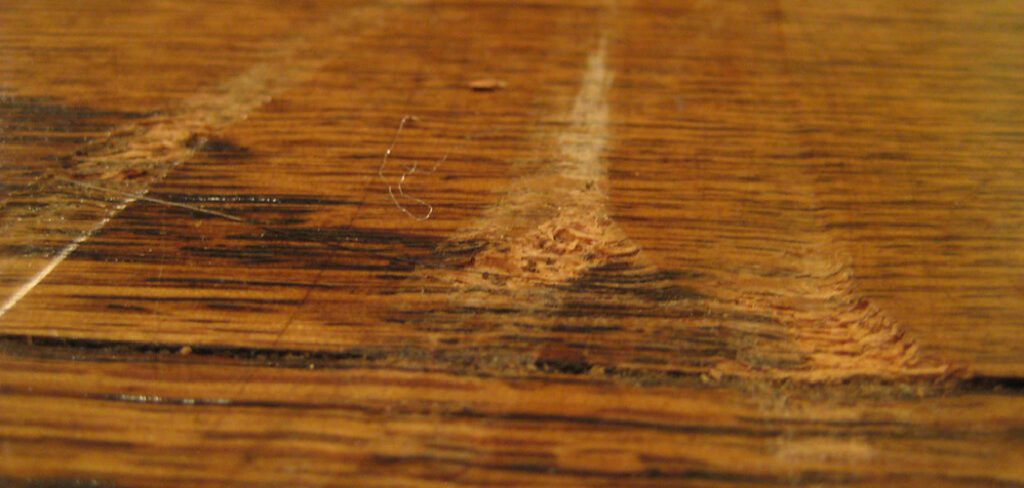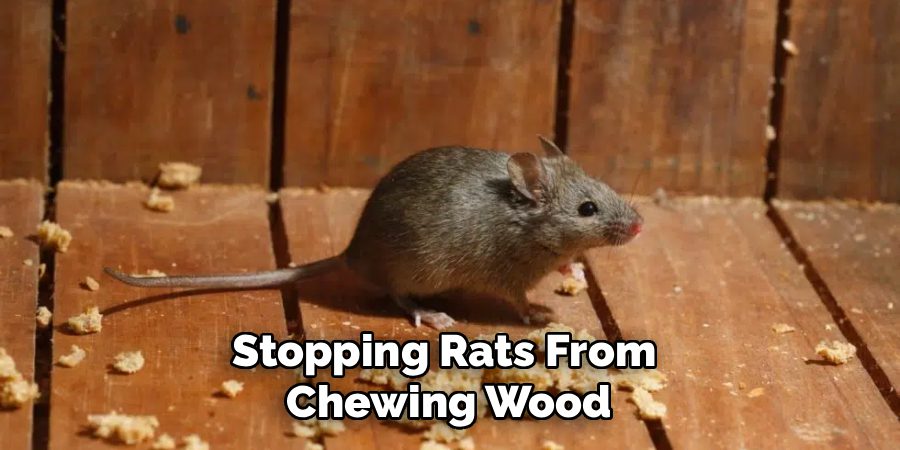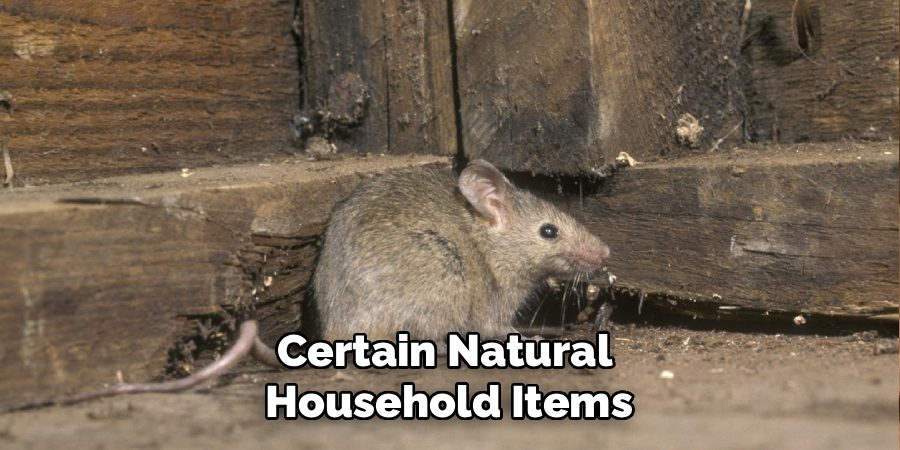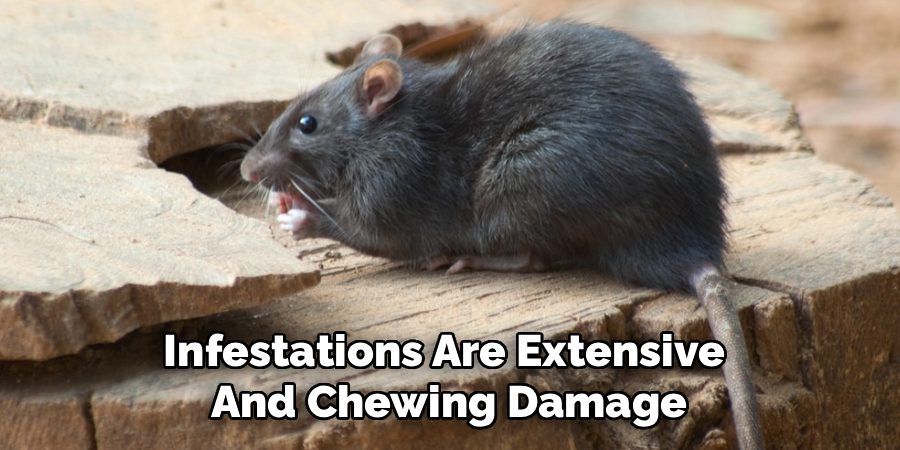Rats can be a persistent and destructive nuisance, especially when they start chewing on wooden structures in your home or property. This behavior is often driven by their need to keep their teeth sharp and short, but it can lead to significant damage and costly repairs if left unchecked. Understanding why rats chew wood and learning effective prevention techniques can help protect your home and maintain a rat-free environment. In this blog post, we’ll walk you through the steps on how to stop rats from chewing wood so that you can get back to using it in no time! So grab your tools, and let’s get started!

Why Do Rats Chew Wood?
Rats have a natural instinct to chew on hard materials, including wood, due to their constantly growing incisors. Their front teeth can grow up to 4 inches every year, and to keep them sharp and manageable, rats gnaw on various surfaces. Wood is an easily accessible and soft material, making it an ideal choice for rats to trim their teeth.
Additionally, chewing allows them to explore their environment and access new spaces, such as breaking through wooden barriers to find food, water, or shelter. This behavior is not just a dental necessity but also a survival strategy, enabling them to adapt and thrive in different surroundings. Understanding this biological drive is key to effectively managing rat infestations and minimizing damage to your property.
Importance of Addressing the Issue
Ignoring the problem of rats chewing wood can have serious repercussions for both your home and your well-being. For starters, structural damage to wooden furniture, walls, or support beams can compromise the integrity of your property, leading to costly repairs over time. Additionally, rats are known carriers of diseases and bacteria, which can pose significant health risks to you and your family.
Their persistent chewing can also create pathways for them to access other parts of your home, exacerbating the infestation. By addressing the issue early, you not only safeguard your property but also maintain a healthier, safer living environment. Taking proactive steps to tackle this problem ensures long-term peace of mind and prevents the situation from spiraling out of control.
10 Methods How to Stop Rats from Chewing Wood
Method 1: Sealing Entry Points with Durable Materials
The most effective starting point in stopping rats from chewing wood is to prevent them from gaining access in the first place. Rats have powerful teeth that grow continuously, making them natural gnawers capable of chewing through wood with ease. To counter this, inspect the exterior and interior of your home or structure for any potential entry points where rats could squeeze in. Gaps around doors, windows, vents, or wooden walls should be sealed with rodent-resistant materials such as steel mesh, metal flashing, or cement. By reinforcing these areas, you eliminate opportunities for rats to chew through wooden surfaces to gain entry. This preventive barrier is one of the most important defenses in protecting wooden structures.

Method 2: Applying Rodent-Repellent Sprays
Another practical method to deter rats from chewing on wood involves using specially formulated rodent-repellent sprays. These sprays typically contain strong-smelling natural oils such as peppermint, clove, or eucalyptus, which rats find unpleasant. To use them effectively, apply the spray liberally along wooden furniture, beams, doors, or any area where rat activity is observed.
The odor discourages rats from chewing, creating a natural deterrent without causing harm. Since sprays can fade over time, it is important to reapply regularly, especially after cleaning. Natural repellents offer a safe and eco-friendly way to protect wood while avoiding the use of harsh chemicals inside living spaces.
Method 3: Using Metal or Plastic Barriers
Because wood is vulnerable to rat teeth, adding a physical protective barrier is highly effective. Covering wooden areas with thin sheet metal, hardware cloth, or heavy-duty plastic guards makes the surface too hard or unappealing for rats to chew. This is especially important for outdoor wooden posts, sheds, fences, or basement beams where rat activity is common. Rats cannot penetrate durable metals, so strategically installing these barriers ensures long-term protection. While it requires some labor and investment, this method provides a reliable and permanent solution compared to temporary deterrents.
Method 4: Employing Ultrasonic Repellent Devices
Technology also plays a role in protecting wood from rats. Ultrasonic repellent devices emit high-frequency sounds that are inaudible to humans but highly irritating to rodents. When plugged into wall outlets or positioned near wooden structures, these devices discourage rats from staying in the area, thereby reducing their chances of chewing wood. While ultrasonic repellents may not be 100% effective on their own, they work best when combined with other methods such as sealing entry points or applying repellents. This multi-layered approach helps keep rats away from valuable wooden furniture or structural woodwork.

Method 5: Removing Food Sources and Nesting Materials
One of the reasons rats target wooden areas is to create pathways, nesting spaces, or access to food. By eliminating what attracts them, you indirectly stop them from chewing on wood. Store food in sealed containers, keep garbage bins tightly closed, and avoid leaving pet food outdoors. Additionally, declutter storage spaces, attics, or basements where rats could gather nesting materials. Without a food supply or a reason to build nests, rats are less likely to remain in the vicinity and chew on wooden structures. Preventing access to these attractants is an essential long-term solution.
Method 6: Installing Traps for Rodent Control
Trapping is another method to directly reduce rat populations and, in turn, minimize damage to wooden surfaces. Traditional snap traps, glue traps, or humane catch-and-release traps can be strategically placed near areas where chewing has been observed. Traps should be baited with attractive food such as peanut butter, nuts, or dried fruits to lure rats effectively. By catching and removing rats, you prevent them from continuing to gnaw through wood. While traps may require ongoing monitoring and resetting, they serve as a direct solution for active infestations and protect wooden areas from further harm.
Method 7: Using Strong-Smelling Natural Deterrents
In addition to sprays, certain natural household items can be used as deterrents to protect wooden areas from rat chewing. Rats dislike strong scents such as ammonia, garlic, onion, or chili powder. Placing cotton balls soaked in ammonia or scattering chili flakes near wooden beams or furniture creates an unpleasant environment for rats. These natural deterrents can be strategically placed in attics, basements, or outdoor wooden sheds where chewing activity has been detected. While this method requires reapplication and monitoring, it offers a chemical-free, inexpensive solution to discourage rats from targeting wood.

Method 8: Encouraging Natural Predators
Rats tend to avoid areas where they sense predators, and this instinct can be used to protect wooden structures. Owning a cat or encouraging natural predators such as owls around your property can deter rat populations. For outdoor spaces, installing owl nesting boxes or keeping pet dogs in the yard may help keep rats away. The presence of predators creates a natural deterrent effect, reducing the likelihood of rats gnawing through wood to gain entry. While not always practical for every household, this method can be particularly effective in rural or semi-rural settings.
Method 9: Reinforcing Wooden Surfaces with Sealants
If rats are determined to chew on wood, making the surface less appealing can reduce the damage. Applying sealants, varnish, or specialized anti-rodent coatings makes the wood harder and more resistant to gnawing. Some commercial products are specifically designed to taste bitter or unpleasant to rodents, discouraging them from chewing. Even if rats attempt to bite, the treated surface discourages prolonged gnawing, protecting the wood from significant damage. This method works well for wooden furniture, baseboards, or outdoor posts that cannot be easily covered with barriers.
Method 10: Seeking Professional Pest Control Services
When rat infestations are extensive and chewing damage is widespread, professional intervention may be the most effective solution. Pest control experts have access to stronger repellents, advanced trapping systems, and knowledge of rat behavior that ensures thorough elimination. They can also recommend structural reinforcements to protect wooden areas and provide long-term preventive strategies tailored to your property. Though it may involve additional costs, hiring professionals ensures that the rat problem is fully addressed, which in turn protects wooden structures from further damage.

Conclusion
Rats are natural chewers, and unprotected wood becomes a prime target when infestations occur. Fortunately, with the right combination of prevention, deterrents, and direct control, it is possible to stop rats from damaging wooden structures and furniture. Sealing entry points, applying repellents, using barriers, eliminating food sources, and reinforcing wood all work together to reduce the risk.
For persistent issues, traps or professional pest control services provide more permanent solutions. By implementing these ten methods, you can safeguard wood from the destructive habits of rats, ensuring both the durability and aesthetic appeal of your wooden investments remain intact. Thanks for reading this blog post on how to stop rats from chewing wood! We hope you found it helpful and informative.
About
Team Woodlix is a distinguished figure in the world of Diy design, with a decade of expertise creating innovative and sustainable Diy solutions. His professional focus lies in merging traditional craftsmanship with modern manufacturing techniques, fostering designs that are both practical and environmentally conscious. As the author of diy, Woodlix delves into the art and science of furniture-making, inspiring artisans and industry professionals alike.
Education RMIT University
(Melbourne, Australia) Associate Degree in Design (Team Woodlix) Focus on sustainable design, industry-driven projects, and practical craftsmanship. Gained hands-on experience with traditional and digital manufacturing tools, such as CAD and CNC software.
Nottingham Trent University
(United Kingdom) Bachelor’s in diyfastly.com and Product Design (Honors) Specialized in product design with a focus on blending creativity with production techniques. Participated in industry projects, working with companies like John Lewis and Vitsoe to gain real-world insights.
Publications and Impact
In diy, Team Woodlix his insights on indoor design processes, materials, and strategies for efficient production. His writing bridges the gap between artisan knowledge and modern industry needs, making it a must-read for both budding designers and seasoned professionals.
